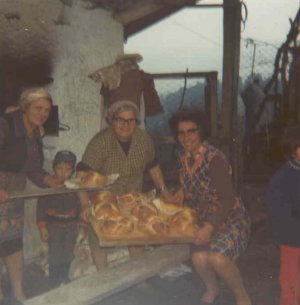 |
[ZAWiW] [gemeinsamlernen] [LiLL] | ||
|
|
|
|
Bread in Memories
Stand:During the Second World War many families moved from Treviso town (North-East of Italy) to the country-side to escape from the bombardements. Even if we paid a lot of money, there was enough to eat and the people didn't suffer from hunger. Here the bread was prepared once a month.The families had their own flour and also salt, but not the necessary yeast. My father worked in town and got it in some way from a baker. He exchanged the yeast with salt and so my mother could prepare the dough for the bread, all manually of course.
Once the loafs were prepared at home, they were taken to the stone-ovens placed at the ourskirts of the villages. There everybody could bake his own bread. The baken bread was put in cloth-bags and hanged on the ceiling, because in war time mice too were hungy.
I can remember one particular happening : an airplane released a bomb on its way to Germany (because they said too much charged) and this hit a bread oven by falling down, but fortunately nobody was hurt. The women hadn't arrived yet for the bread baking.


